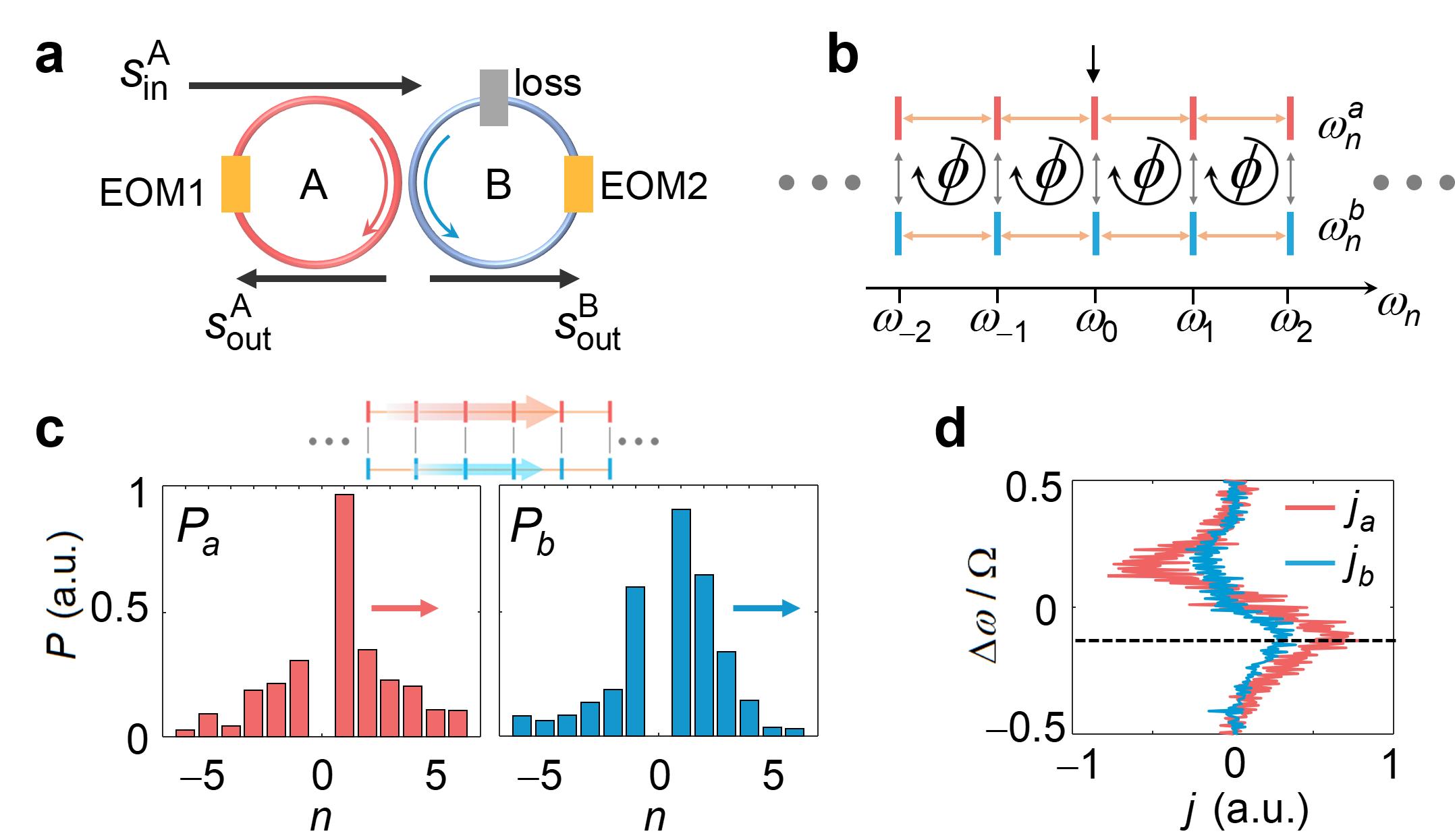
Time:2025-01-10 Read:1079
Chiral currents at opposite boundaries of two-dimensional topological materials are featured by robust one-way transport but in opposite directions. Recently, it was found that the broken chirality in a topological system leads to anomalous topological phenomena with the so-called antichiral currents, where edge currents at two boundaries co-propagate in the same direction. This counterintuitive phenomenon complements chiral currents and brings a new control knob to functional wave guiding. However, such chiral symmetry breaking in edge currents mainly based on the modified Haldane model, and has only been experimentally demonstrated in Hermitian microwave systems.

Figure 1. Observation of the chirality breaking in the synthetic frequency dimension. a, Two identical coupled fiber ring resonators are modulated by two electro-optic phase modulators (EOM1, EOM2). The black arrows denote the input and drop-port fibers for inject and readout light. b, The synthetic two-leg Hall ladder in the frequency space of the two coupled ring resonators. The black arrow represents the initial excitation of the input laser. c, Measured steady-state normalized mode distributions on the two legs for the frequency detuning of the black dashed line in (d). The red and blue arrows in the figure denote the directions of currents on each leg. The top panel denotes the schematic of positive antichiral currents for this frequency detuning. d, Measured steady-state chiral currents for different frequency detunings. a.u. represents arbitrary units.
The researchers study a ladder Hall lattice model with effective magnetic fields and on-site gain/loss, where they reveal that the non-Hermitian mechanism can lead to the destruction of the chirality of the chiral currents, resulting in the antichiral currents in the optical regime. Experimentally, the researchers use two equal fiber ring resonators A and B as shown in Fig. 1a and apply resonant phase modulation to both rings, so that the frequency modes in each ring resonator are coupled, and thus a synthetic ladder Hall lattice is constructed in the frequency dimension. The phase difference introduced by the phase modulator provides an effective magnetic field for the lattice. At the same time, an additional loss is added to the ring B, so that the two legs of the synthetic Hall lattice have a loss difference. The leg a with a smaller loss has an equivalent gain, while the leg b with a larger loss has an equivalent loss. In doing so, a non-Hermitian Hall ladder lattice with equivalent gain and loss is constructed in the synthetic frequency space, as shown in Fig. 1b. The steady-state mode distribution on the two legs is measured experimentally by exciting the leg a, and the magnitude of the currents on the two legs is then obtained. The steady-state mode distribution at a certain frequency detuning measured in experiments is shown in Fig. 1c. It can be seen that the currents on the two legs propagate in the same direction, which proves the existence of antichiral currents in the system. The antichiral currents corresponding to the entire band range are shown in Fig. 1d.
In addition, the researchers further analyze the potential correspondence between the antichiral currents and the non-Hermitic skin effects in the system, and verify the existence of skin effects in the system by measuring the windings of energy bands in the complex plane. Finally, the researchers realize a non-Hermitian lattice with a large winding number by introducing long-range coupling, and measure the antichiral currents in the system. This work, for the first time, use non-Hermitian mechanism to realize optical antichiral currents, and provides a method to probe the existence of skin effect without an open boundary condition. The observed antichiral currents in the synthetic frequency lattice is topologically robust, so it is of great significance in the study of topologically-protected unidirectional frequency conversion devices. The results of this study not only expand the study of antichiral topological phase, but also lay a foundation for the study of higher-dimensional non-Hermitic physics based on the synthetic frequency dimension.
The research was published in “Rui Ye, Yanyan He, Guangzhen Li, Luojia Wang, Xiaoxiong Wu, Xin Qiao, Yuanlin Zheng, Liang Jin, Da-Wei Wang, Luqi Yuan, and Xianfeng Chen, Observing non-Hermiticity induced chirality breaking in a synthetic Hall ladder, Light: Science & Applications, 14, 39 (2025)”.
Link : https://www.nature.com/articles/s41377-024-01700-1